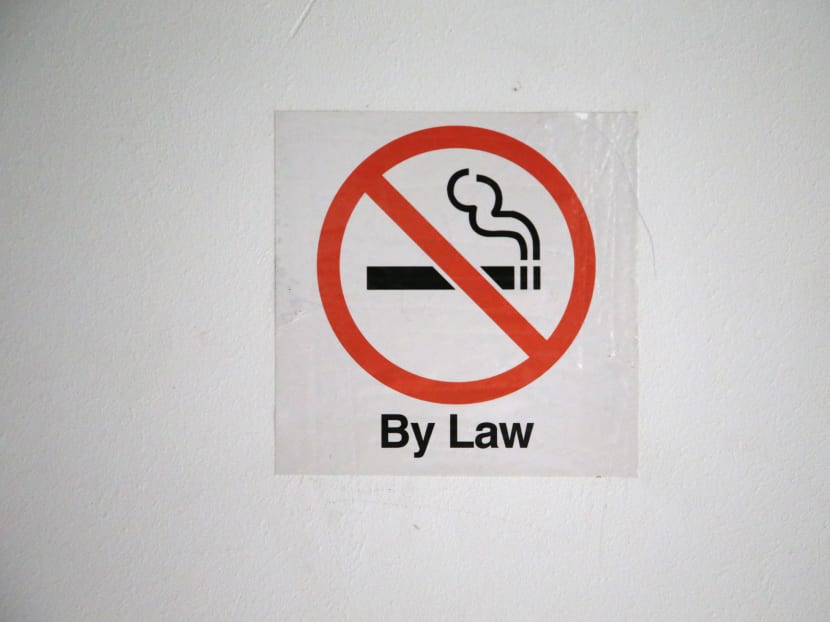Ban smoking at windows and balconies: MP Louis Ng
SINGAPORE — A parliamentary committee is proposing that the Government ban people from smoking near windows and at the balconies of Housing and Development Board (HDB) flats and private apartments, in order to curb the harmful effects of secondhand smoke.

Dr Amy Khor said that the best way to protect against secondhand smoke is for family members and neighbours to help smokers cut down and quit smoking.
- Residents have complained of secondhand smoke entering their homes, more so after stay-home curbs began, MP Louis Ng said
- A committee he heads is calling for a ban on smoking at windows and balconies of public and private residences
- Dr Amy Khor said the Government has already banned smoking in common areas to protect the public from secondhand smoke
- Installing cameras to catch people who smoke by their windows or balconies is “intrusive”, she said
- Government will instead encourage people to take greater social responsibility and facilitate conversations between neighbours
SINGAPORE — A parliamentary committee is proposing that the Government ban people from smoking near windows and at the balconies of Housing and Development Board (HDB) flats and private apartments, in order to curb the harmful effects of secondhand smoke.
In response, Dr Amy Khor, who is Senior Minister of State in the Ministry of Sustainability and the Environment, said that such a ban may not be the “silver bullet” for the problem, as she outlined several constraints such as privacy concerns and enforcement challenges.
Instead, the Government will take a 3-pronged approach, namely:
Engendering greater social responsibility
Examining more ways to facilitate productive conversations between neighbours to deal with difficult situations
Working with agencies to study how these disputes can be better addressed
The suggestion of a ban was put forth by the Government Parliamentary Committee (GPC) for Sustainability and Environment.
It is headed by Mr Louis Ng, the committee’s chairman and Member of Parliament (MP) for Nee Soon Group Representation Constituency (GRC), who tabled this Adjournment Motion on Monday (Oct 5).
WHY PROPOSE A BAN
Mr Ng has been getting feedback from residents in his constituency about this problem, particularly after stay-home curbs began in April due to Covid-19.
In the first four months of this year, he said that the National Environment Agency (NEA) received 11,400 complaints related to smoking, a 20 per cent jump from the same period last year. This spike was largely due to people smoking in or near their homes, he added.
He also spoke about residents’ frustration when secondhand smoke enters their homes, and their helplessness over the health risks that their families might face.
Mr Ng said that the GPC’s proposal is “very similar” to what NEA officers already do in issuing advisories to residents against smoking near windows or at the balconies to minimise the amount of cigarette smoke emitted from their premises.
“All our proposal does is empower our officers to enforce the advisory.”
In the past, NEA had said that restricting people’s actions in HDB flats would be an “intrusive regulatory approach.”
However, Mr Ng said that the law “already intrudes on people’s behaviour within their own homes” in other aspects.
“Why do we draw the line at nudity, pets and feeding wildlife, but not at secondhand smoke — something that kills hundreds of people in Singapore a year?” Mr Ng questioned. He was referring to how it is illegal to walk around naked in HDB flats if people can still catch sight of it, or that cats are not allowed as pets in HDB flats.
HOW TO ENFORCE THE BAN
Mr Ng also highlighted in his speech that the committee’s proposal can be enforced through existing technology already used on the ground, such as how the NEA uses cameras to catch high-rise litterbugs and thermal surveillance cameras to catch residents smoking in prohibited areas.
“We have years of experience fine-tuning (the use of such tools) to minimise privacy intrusion and to maximise successful enforcement.
“What's missing now is just the legislation. If the minister's reply is that these technologies are not viable, then NEA should implement alternative solutions to facilitate enforcement.”
WHY COMPLAINTS HAVE GONE UP
With more people working from home since April because of Covid-19, Mr Ng said that the number of disputes over cigarette smoke brought up to the Community Mediation Centre (CMC) rose from two to eight cases a month.
He spoke about how a woman applied to resolve the matter through CMC, but her neighbours refused to attend the mediation session, insisting on their right to smoke within their own home. Similarly, the MPs she approached told her that they are “powerless” and “their hands are tied”, he said.
“These (cases) highlight why talk isn’t enough. Mediation (through CMC) is voluntary and does not work when neighbours refuse to participate.”
Apart from Mr Ng, Mr Derrick Goh, another Nee Soon GRC MP, also touched on the issue during a debate on changes to the Environmental Public Health Act.
Mr Goh said that over the last few months, he has received more feedback from residents about exposure to cigarette smoke wafting into their flats from neighbours who smoke.
“A practical way is to, perhaps, require resident smokers to close their windows and doors when smoking. This solution aligns to existing NEA regulations that require windows of private vehicles to be fully wound up so that no secondhand tobacco smoke is expelled when the driver smokes,” he added.
WHAT DATA SHOWS
In her reply, Dr Khor told the House that of the 11,400 smoking complaints received in the first four months of the year, 58 per cent of the complaints were in residential estates.
However, 95 per cent of these complaints were related to smoking in common corridors, staircases and void decks, while 5 per cent were about smoking done in homes.
For complaints related to smokers who do so in their homes, Dr Khor said that NEA, town councils and grassroots leaders take an educational approach, and advise smokers to be considerate and not smoke near windows and at balconies.
For those who do not take heed, grassroots leaders and the relevant agencies will help to mediate between neighbours and discuss what adjustments may be made.
Residents may turn to CMC or raise the matter to the Community Disputes Resolution Tribunals as a last resort.
The tribunals are specialised courts that hear cases of disputes between neighbours after all efforts including community mediation have been exhausted. These pertain to claims between neighbours over issues related to the enjoyment or use of places of residences.
Between January last year and July this year, 25 claims relating to excessive smoke, caused by cigarettes or incense, were filed with the tribunals and “quite a number” of claimants were able to resolve issues amicably without proceeding to the tribunals, Dr Khor noted.
WHY IT WILL BE TOUGH TO ENFORCE
On the proposed ban, she said that such legislation could be highly intrusive and there are “significant practical challenges in enforcement that limit effectiveness”.
“First, enforcement will be challenging as capturing evidence of the smoking offence is not straightforward,” she said, explaining that surveillance cameras must capture the smoker smoking or holding a lighted cigarette as evidence, but a smoker can easily hide to avoid detection by the camera.
To capture the smoking act, the camera must also be placed at suitable vantage points to capture footage at a window or balcony, meaning it will be aimed directly into homes, which is “highly intrusive”.
This is unlike surveillance for high-rise littering where the camera is trained at the building facade and can be placed at ground level some distance away.
WHAT THE GOVERNMENT CAN DO
To tackle this problem, the Government will instead pursue a three-pronged approach, which starts by working harder to engender greater social responsibility, Dr Khor said.
“This means instilling consideration for the health and well-being of those around us, not just family members but also our neighbours. We must entrench new social norms of what constitutes acceptable behaviour.”
NEA will work with other agencies to explore effective ways of doing this, for example, by developing targeted messages on exercising social responsibility and acceptable social norms.
Secondly, the Government will examine more ways to facilitate productive conversations between neighbours to deal with difficult situations, before they escalate into intractable disputes, she said.
Lastly, the Government will work with agencies to study how these disputes can be better addressed by the inter-agency Community Dispute Management Framework.
“The best way to protect against secondhand smoke is for family members and neighbours to help smokers cut down and quit smoking,” she said. “And if they have to smoke, not to light up at home and instead smoke at non-prohibited areas.”
WHAT THE GOVERNMENT HAS DONE
Responding to Dr Khor in a supplementary question, Mr Ng was adamant and questioned why cameras cannot be repurposed to detect smokers.
“Why can't we use this same camera to capture someone smoking at their windows or the balconies and not pointing inside to the house?” he asked.
“So if they're lying on a bed and smoking, that's okay. I'm just saying move (the smokers) away from the windows and balcony so that it minimises, not completely eradicates, but minimises the effects of secondhand smoke on the neighbours.”
“I think the problem is that we are viewing this as a neighbourly dispute issue… if we view this as a public health crisis, then the policy direction and the policy outcome might be completely different,” Mr Ng said.
Dr Khor rebutted that the Government has not been handling the situation as a neighbourly dispute, which is why there is legislation to ban smoking in the common areas to protect the public from secondhand smoke.
There are 32,000 places now where smoking is prohibited, she said.
She kept to the stance about the difficulties in enforcing the use of optical cameras and thermal cameras for residences, and highlighted that the daily smoking prevalence has gone down from 18.3 per cent in 1992 to 13.9 per cent in 2010, then to 10.6 per cent last year as a result of the Government’s efforts.











